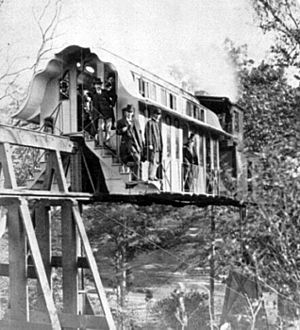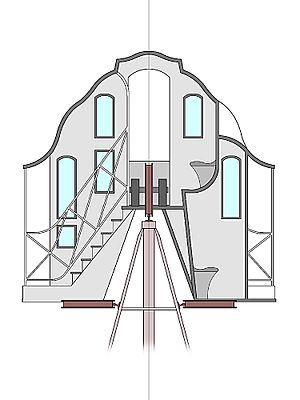Centennial Monorail facts for kids
The Centennial Monorail was a special train shown off at a big event called the Centennial Exposition in 1876. This event was the first official World's Fair held in the United States. It took place in Philadelphia, Pennsylvania, to celebrate 100 years since the Declaration of Independence was signed. General Roy Stone was the person who created and demonstrated this unique monorail.
How it Worked
The monorail track was about 155 meters (or 170 yards) long. It connected two main buildings at the exhibition: the Horticultural Hall and the Agricultural Hall, both located in Fairmount Park. Only one special train car used this track.
The Unique Train Car
This train car was very fancy and had two levels, like a double-decker bus. It was designed in a beautiful Victorian style. The car had two main wheels that carried its weight. These wheels had a special double-flange design. One of these wheels was powered by a "La France" type rotary steam engine.
The Track Design
The way the monorail worked was similar to another design called the Lartigue Monorail. The main rail that held the train's weight was placed on top of wooden A-shaped frames. Below this main rail, about 1.3 meters (4 feet 5 inches) down, there were two smaller guide-rails. These guide-rails helped keep the vehicle balanced and steady.
Engine Details
The large wheels that carried the monorail had a diameter of 711 millimeters (28 inches). The steam engine's boiler was like those found in regular steam trains. It was quite long, about 6.4 meters (21 feet), and had a diameter of 863 millimeters (34 inches). The driver's area was at the back of the train car. Just below the driver, there were two water tanks, with coal piled up behind them to fuel the engine.
Later Use
A slightly changed version of this monorail was later used in 1878. It ran on the Bradford and Foster Brook Railway in Pennsylvania.



